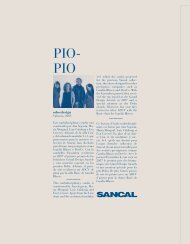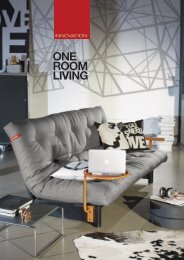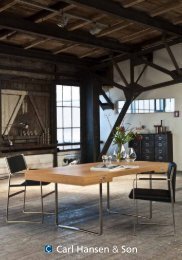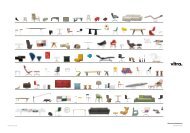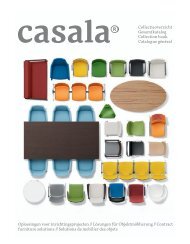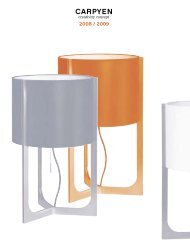You also want an ePaper? Increase the reach of your titles
YUMPU automatically turns print PDFs into web optimized ePapers that Google loves.
REPUBLIC OF FRITZ HANSEN <br />
The name Republic of Fritz Hansen encapsulates the<br />
entire 137-year history of the company. From the<br />
founder, visionary cabinet maker Fritz Hansen, to the<br />
architects and designers, creators of furniture, prized<br />
and coveted the world over. The history is all about<br />
being open to new currents, about thinking big and<br />
outside the box, about development and renewal in<br />
line with one’s own principles and origins.<br />
The story begins in 1872. Fritz Hansen, master cabinet-maker<br />
aged 25, leaves his home town of Nakskov for the capital,<br />
Copenhagen, obtains a trade license and sets up his �rst cabinet<br />
making business in small rented premises.<br />
1885 is a decisive year. Fritz Hansen starts a furniture production<br />
of his own, with his own furniture programme. In 1898, a sawmill is<br />
established north of Copenhagen, in Lillerød. Fritz Hansen is<br />
already well known for quality, as has been a matter of course ever<br />
since. In 1899, Fritz Hansen hands the business over to his son,<br />
Christian E. Hansen. Amongst other prestigious contracts, he wins<br />
orders for the Danish Parliament at Christiansborg Castle and for<br />
Copenhagen Town Hall, where the outcome of the �rst recorded<br />
collaboration with an architect, Martin Nyrop, is the Townhall chair.<br />
Christian E. Hansen is just as forward-looking as his father, and<br />
the company develops into an industrial manufacturer, inspired by<br />
the budding functionalism of the period, introducing new materials,<br />
new production technologies and a whole new design language.<br />
Thanks to him, Fritz Hansen becomes, in only a few years in the<br />
1920s, capable of steam-bending beech just as successfully as<br />
world leaders in the �eld. Steam-bent wood makes it possible to<br />
produce furniture which is light and strong.<br />
In 1932, Søren and Fritz Hansen, Fritz Hansen’s grandsons,<br />
become co-directors. Having spent many years abroad, they have<br />
a broad, international horizon, and together with their father, they<br />
launch the �rst steel furniture in Denmark already in 1931 inspired<br />
by, among others, Mies van der Rohe. The furniture draws praise in<br />
New York, but not in Denmark.<br />
During the 1930s, the furniture maker begins to work with the<br />
most highly regarded and forward-looking architects of the time.<br />
Kaare Klint and the Church chair represent the �rst important<br />
collaboration. Thanks to the progressive architect Hans J. Wegner,<br />
the world welcomes in 1944 the China Chair , a sculptural<br />
celebration of wood and the craft of furniture making of the<br />
heighest order.<br />
Collaboration with Arne Jacobsen begins in 1934, but his star<br />
does not rise until 1952, when he discovers the wonders of<br />
lamination, a technique re�ned to perfection by Søren Hansen. The<br />
direct cause is the Ant chair. This three-legged, pressure moulded<br />
stackable chair is commissioned by Novo Nordisk for their canteen.<br />
The Ant subsequently gives rise to a range of pressure moulded<br />
veneer chairs, of which Series 7 with four legs and armrests<br />
achieves higher sales than any other chair in the company’s history.<br />
Arne Jacobsen goes on to design the Egg chair and the Swan <br />
chair for his own modernist masterpiece, the Royal Hotel in the<br />
centre of Copenhagen. Today, these items of furniture are internationally<br />
recognised as style icons, the result of challenging,<br />
inspirational collaboration between Fritz Hansen’s most talented<br />
cabinet makers and Arne Jacobsen. Later, the Oxford chair<br />
becomes part of the overall design for St. Catherine’s College. This<br />
chair represents the quintessential Fritz Hansen design, radiating<br />
originality, simplicity and lightness presented with sculptural impact.<br />
In 1951, Poul Kjærholm becomes an indispensable part of Fritz<br />
Hansen’s history and distinguishing features, but he leaves the<br />
company because of disagreements over the prioritisation of his<br />
and Arne Jacobsen’s projects. Poul Kjærholm’s furniture challenges<br />
traditional Danish furniture architecture, setting new standards for<br />
Scandinavian furniture design. Kjærholm’s furniture is minimalism<br />
with an industrial dimension, radiating discrete exclusiveness. This<br />
is why, in 1982 when Fritz Hansen is again able to produce his<br />
furniture, it becomes a natural part of the range. In 1965, the world<br />
famous architect Henning Larsen enters the scene, just as the enfant<br />
terrible of Danish design, Verner Panton, becomes leader of the<br />
avant-garde, provoking and inspiring in the service of Fritz Hansen.<br />
In 1968, Piet Hein and Swedish Bruno Mathsson design the<br />
Superellipse table, a democratic table with no ends.<br />
Throughout the 1980s and 90s, Fritz Hansen demonstrates the<br />
company’s international orientation through cooperation with<br />
leading international authorities on design such as German<br />
Burkhardt Vogtherr and Italian Vico Magistretti.<br />
At Fritz Hansen, the concept Danish Design has taken on a




